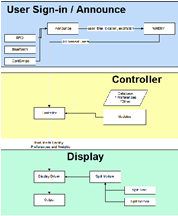Jan 25, 2007
Prospero - A "Visual Commons" Framework for Community-Aware Public Displays
Re-blogged from Networked Performance

Information about the community as a commons and about commons in the community can be useful for promoting a sense of shared fate and shared identity. In addition, as mobility increases, information about how a community moves into, out of, and through its spaces (such as public commons) can be a useful source of community feedback. A new project at the University of Michigan investigates using public displays to understand and represent community dynamics and preferences:
Prospero is an infrastructure to enable public displays to reflect evolving public participation. The objectives of the Prospero project arise from two primary motivations: one descriptive, the other normative. First, technologies that foster cooperation enhance our relationship to our surroundings. Many of these technologies incorporate user feedback in real-time.
Second, our team members believe that a society in which collective decision-making is based on participatory democracy and public resources should be allocated not by top-down or centrally-controlled mechanisms, but on the basis of the expressed desires and needs of participants. As cooperation increases, we have seen a resurgence of "the commons," i.e. that public sphere in which community values are expressed.
In our project, we shall explore this theme through its instantiation in the specific domain area of public displays. In much of modern life, public spaces, public media and public art are designed to send us messages that we passively receive, process and absorb. However, we believe that in a democracy, citizens must actively shape the public sphere. This necessitates "talking back" to the elements that constitute the public sphere. Public displays, that is, displays located in public spaces and accessible to a public, constitute an increasingly important element of the public sphere. We will develop an infrastructure for community-aware public displays that are controlled by users' expressed needs and preferences; we see our endeavor as part of an ongoing, democratic reclaiming, by citizens, of control over an increasing number of aspects of the public sphere in general.
Thus, by making a public display that is attentive to its community of users, a Visual Commons, it becomes possible for the community to escape the present hegemony of one-way communication, or "broadcast," of generic information (such as the time, or stock prices) or the barrage of mass-media advertising (such as occurs in New York City's Times Square). In effect, dynamic processing of community feedback regarding the contents of the display enables it to become more than just a billboard.
22:00 Posted in Information visualization, Social Media | Permalink | Comments (0) | Tags: social computing







The comments are closed.